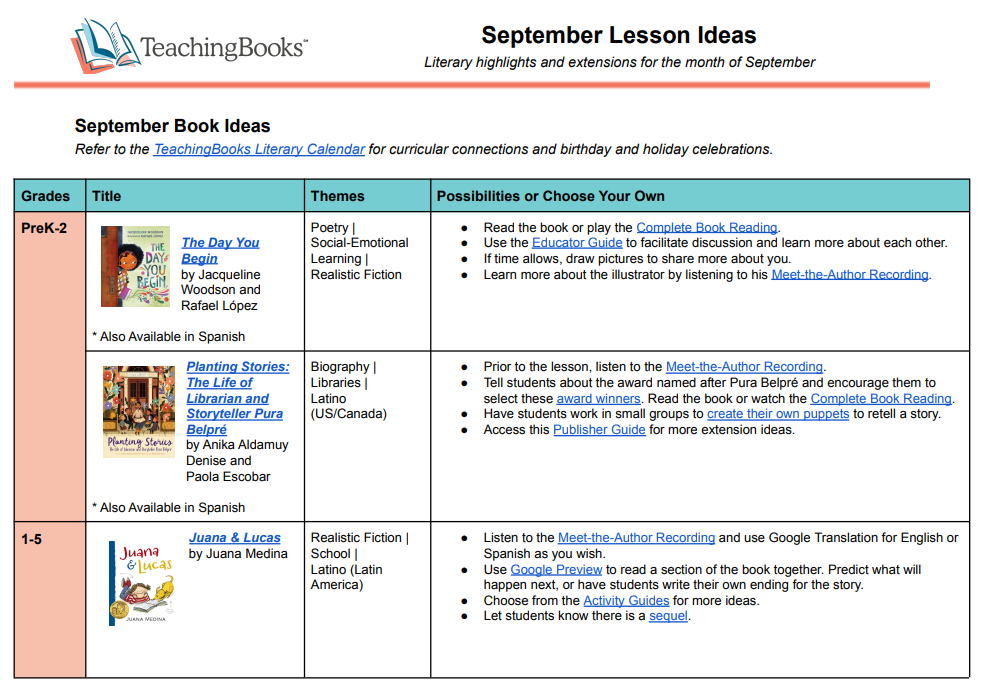Ready-to-Use Ideas
Access ideas for mini-lessons, bell-ringers, and interactive activities to practice skills, demonstrate understanding, and prompt discussions.
Classics Reimagined (9-12)
Infuse TeachingBooks resources into your high school ELA curriculum. These ideas can easily be transferred to other classics/texts.
1984 | The Bluest Eye | The Catcher in the Rye | The Great Gatsby | The House on Mango Street | Lord of the Flies | Macbeth | The Odyssey | Romeo & Juliet | To Kill a Mockingbird
1984
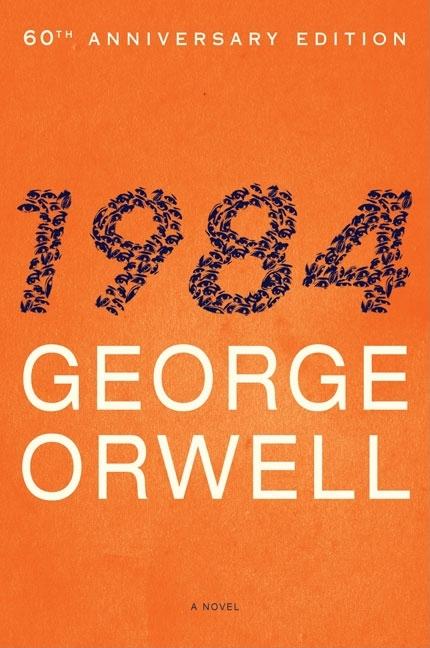
Use the Dystopia Lesson from Read Write Think and find the section titled “Dystopias: Definitions and Characteristics” to consider the characteristics of a dystopia.
Then, listen to the audio excerpt and write down any characteristics of dystopia that you can detect. Which did you choose, and why?
Watch the video book trailer. Compare to book trailers of other dystopian novels such as The Testing and All Rights Reserved and think back to those characteristics of a dystopia that you’ve already outlined. Which characteristics appear across all the trailers? Why do you think these particular characteristics show up the most often?
The Bluest Eye

Listen to this audio excerpt of the first pages of The Bluest Eye. Note what the reader’s voice is doing in terms of tone and speed and how it reflects the way the text is structured in the book. What is the purpose of repetition and change here?
Listen to the Meet-the-Author Recording for Alicia D. Williams' Genesis Begins Again, where she talks about colorism. How do her comments apply to Pecola’s experiences in The Bluest Eye? What is the cultural significance of these conversations happening in contemporary young adult literature?
Use the Cultural Representation Reflection to think about differences and similarities in your own lives to those of the characters in The Bluest Eye.
The Catcher in the Rye
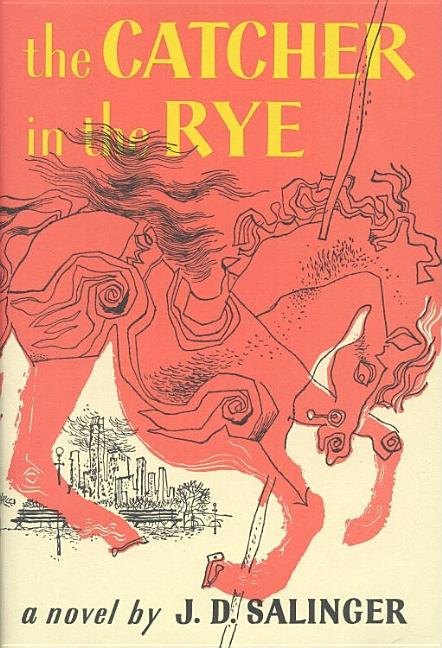
Use this lesson plan from Think Map Visual Thesaurus to map the vernacular terms Holden uses in The Catcher in the Rye. Do any of these terms resonate with you today? What contemporary terms (that are appropriate to share in a classroom) carry similar meaning?
Take a look at this list of Read Alikes for The Catcher in the Rye. Pick two books from the list and read their summaries. Use what you learn in the summary to explain why you think the books are read alikes for The Catcher in the Rye.
Working with a partner, fill out the Text Complexity rubric for this title. Use textual evidence to support your ideas. Which categories did you and your partner immediately agree on regarding ratings? Which ones required more discussion, and why do you think that is?
The Great Gatsby

Use Lesson 5 in this teacher’s guide to consider figurative language in the text. Then, use the Google Preview of this graphic novel adaptation to view how the story can be told through images. Which figurative language elements are represented visually in the graphic novel, and how so?
Listen to the audiobook excerpt of the first three pages of The Great Gatsby and write down any themes you detect. Then, explore graphic adaptation further by using a Graphic Novel Multi-Leveled Lesson to analyze the first several pages of the graphic novel. What choices do the writer and illustrator make to demonstrate the essence of these first few pages of the novel?
Listen to the audiobook excerpt from Anna-Marie McLemore’s Self-Made Boys, a queer Great Gatsby retelling. Compare to the opening scene in The Great Gatsby. What changes does McLemore make to her adaptation, and what similarities do you detect? Why might a revision of The Great Gatsby featuring new voices be important?
The House on Mango Street
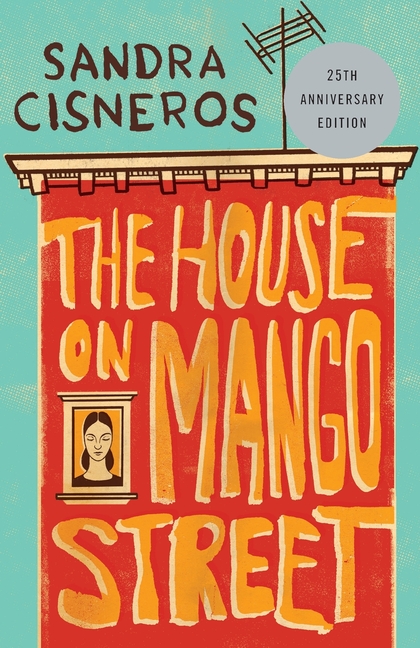
Listen to this audiobook excerpt. Now, write the scene from the perspective of one of the three sisters. What did you choose to emphasize and why?
Watch the video of On Writing with Sandra Cisneros. As you watch and listen, write down the lines or ideas that resonate with you. How might you relate what Cisneros highlights in this video to Esperanza’s experiences in The House on Mango Street?
Watch the trailer for the theatrical production of The House on Mango Street. What are the major differences between the theatrical adaptation and the book? What omissions do you notice, and how do they affect your perception of this story?
Lord of the Flies

Watch the trailer for The 100, the CW adaptation of a book that many have compared to Lord of the Flies. What echoes of Lord of the Flies do you see? What is the significance of taking those elements of Lord of the Flies and adapting them to a science fiction environment?
Use Read Write Think’s text messaging assignment to imagine Lord of the Flies in our own era.
List out the themes you recognize in the novel, then watch the three video trailers for adaptations. How do these themes come through visually? Which themes are most apparent?
Macbeth

Use the Poetry Multi-Leveled Lesson to explore Shakespeare’s use of language.
Have students act out the 32-second Macbeth from the Folger Lesson Plan. Then discuss what major characters and elements from the full-length play made it into the 32-second version and why.
Consider contemporary YA adaptation with Hannah Capin’s Golden Boys Beware (originally titled Foul is Fair). Use the Google Preview to read the first few chapters, and then consider the following questions: What similarities do you see in character, plot, and theme? What is the purpose of adapting Macbeth from Lady Macbeth’s point of view in a contemporary setting?
The Odyssey

Read pages 1-13 of Gareth Hinds’ graphic adaptation of The Odyssey using the Google Preview option. Compare the illustrated version with its corresponding scenes in the original. How does the artist convey the scene beyond words?
Next, think more about adaptation by reading Gareth Hinds’s Guest Blog Post on creating art for adapted works. Using this information for context, consider the artistic choices he made in adapting The Odyssey. What elements of the story did he omit or enhance from the scene you read?
Listen to the Meet-the-Author Recording for Madeline Miller’s Circe, a retelling of The Odyssey from the goddess Circe’s perspective. Note how Miller says she wanted to “flip the script” and give a cameo character a story of her own. Brainstorm other characters in The Odyssey you think deserve their own stories. Consider what their story could be and describe it in a free write.
Romeo & Juliet
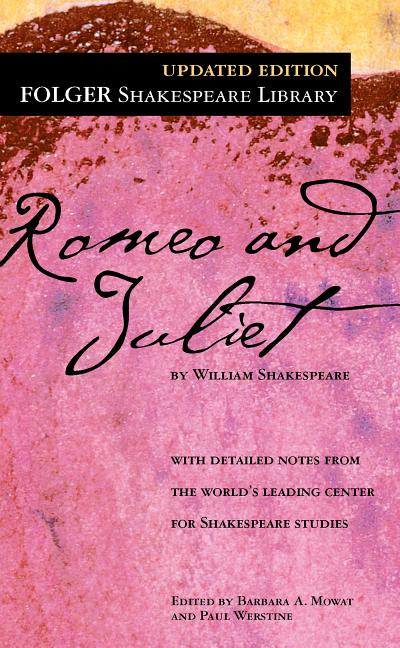
Pick three book trailers to watch and compare. Then answer the following questions:
What aspects of the plot of Romeo & Juliet do they highlight?
Why do you think the creators chose these particular elements to highlight?
What do these elements tell you about the themes of the play?
Listen to the Meet-the-Author Recording for Chloe Gong’s These Violent Delights, a YA retelling of Romeo & Juliet. What reasons does Gong give for choosing Romeo & Juliet as her source story? If you were to write your own retelling of Romeo & Juliet, what setting would you choose and why?
To Kill a Mockingbird

Watch the Boo Radley character video and use that as a model to analyze another character of your choosing. Then create your own video for the character you analyzed.
Watch the trailer for the graphic novel version of this book. Pick a scene to draw from the original version that you're reading and create your own graphic novel spread.
Pick three books from NCTE’s Refreshing the Canon list of To Kill a Mockingbird Read Alikes. Read the book descriptions for each one, then write where you see similarities or contradictions between this book and To Kill a Mockingbird. Why do you think these books are on this list as alternatives to To Kill a Mockingbird?
Genre Studies
Insight from Authors
Interactive Spaces & Activities
Encourage exploration in your libraries and classrooms with these teaching tools.
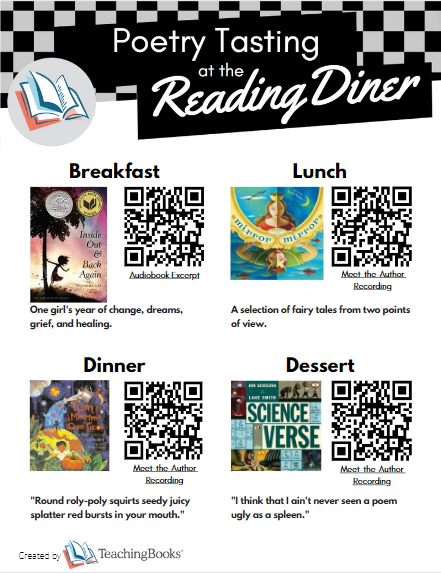
Poetry
Explore TeachingBooks
Shelf Talkers
Monthly Lesson Ideas
Picture Book Engagement
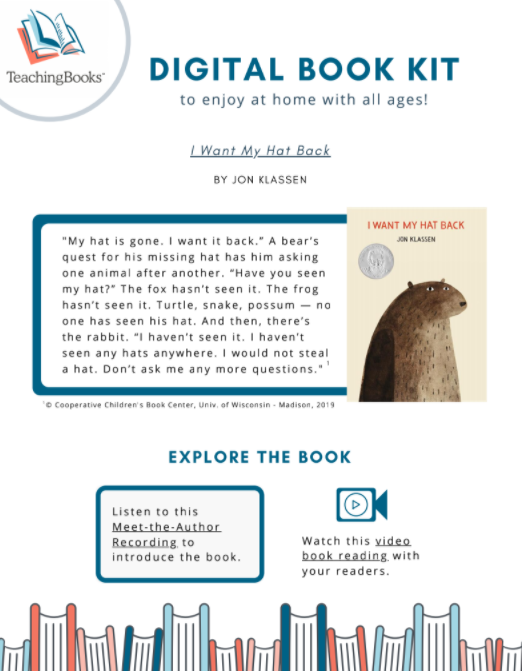 Use these Digital Book Kits to support family engagement with stories.
Use these Digital Book Kits to support family engagement with stories.
- A Different Pond by Bao Phi and Thi Bui
- Alma and How She Got Her Name by Juana Martinez-Neal
- The Crayon Man: The True Story of the Invention of Crayola Crayons by Natascha Biebow
- Fry Bread: A Native American Family Story by Kevin Noble Maillard
- Herizon by Daniel W. Vandever
- I Want My Hat Back! by Jon Klassen
- The True Story of the 3 Little Pigs by Jon Scieszka and Lane Smith
Writing Ideas
Provide opportunities to reflect and respond as authors discuss their craft.
Compare and Contrast
- Journaling Styles 1-12
Listen and Respond
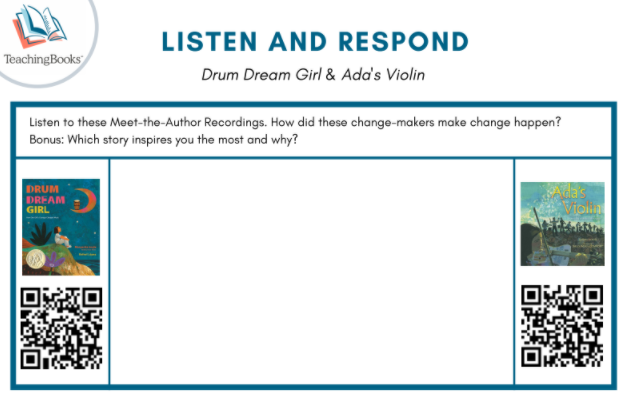
- Drum Dream Girl & Ada's Violin 1-5
- Dreamers 1-5
- Symphony for the City of the Dead 7-12
- The Skunk & Toys Go Out 1-5 | 4-8
- Immigration: Dreamers & The Night Diary 1-8
- Activism: The Day the Crayons Quit 1-5
- Activism: Sofia Valdez, Future Prez & All the Way to the Top 1-5
- Activism: Ghost Boys & Woke 4-12
- SEL (Celebrating Differences): Just Ask & You Are (Not) Small K-5
- SEL (Celebrating Differences): Inside Out & Back Again & The Year I Flew Away 4-8
- SEL (Celebrating Differences): If I Ever Get Out of Here & When Dimple Met Rushi 7-12
- Celebrating Differences 1-5
Activities: Authors Inspire Us 1-5
This set of lesson cards can be used to support learning about author's purpose or inspiration and the writing process.
- Scan the QR codes on the front of the card
- Listen and learn directly from authors
- Reflect and respond
Authors Inspire Us 1-5: Set A
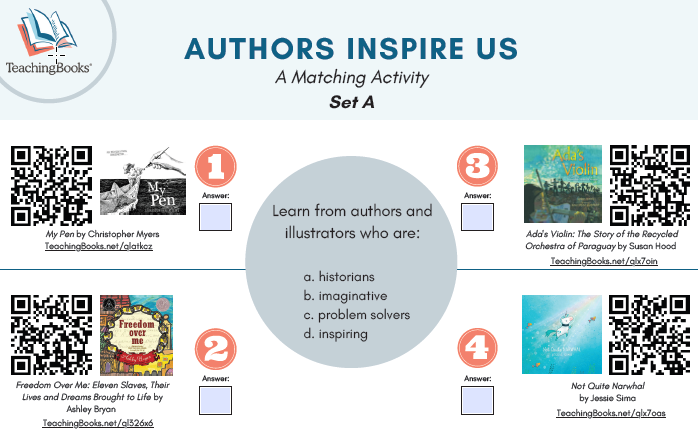
Authors and illustrators are:
a. Historians b. Imaginative
c. Problem solvers d. Inspiring
Answer Key: 1(d), 2(a), 3(c), 4(b)
Resources:
- My Pen narrated by Christopher Myers (empowering) | Meet-the-Author Recording
- Freedom Over Me by Ashley Bryan (historians) | Meet-the-Author Recording
- Ada's Violin by Susan Hood (problem solvers) | Meet-the-Author Recording
- Not Quite Narwhal by Jessie Sima (imaginative) | Meet-the-Author Recording
Authors Inspire Us 1-5: Set B
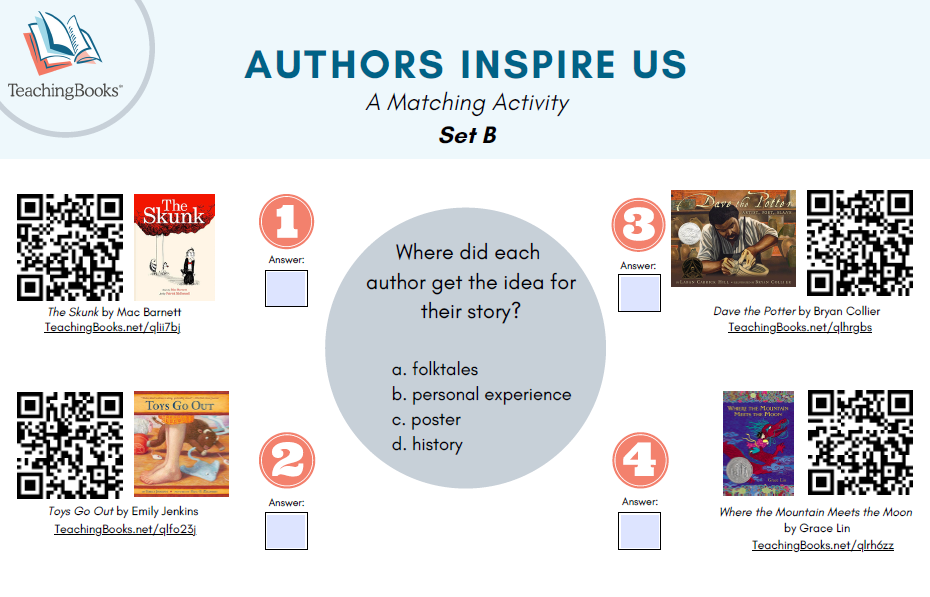
Where did each author get the idea for their story?
a. Folktales b. Personal experience
c. Poster d. History
Answer Key: 1(c), 2(b), 3(d), 4(a)
Resources:
- The Skunk by Mac Barnett and Patrick McDonnell (poster) | Meet-the-Author Recording
- Toys Go Out by Emily Jenkins (personal experience) | Meet-the-Author Recording
- Dave the Potter by Bryan Collier (history) | Meet-the-Author Recording
- Where the Mountain Meets the Moon by Grace Lin (folktales) | Meet-the-Author Recording
Activities: Authors Inspire Us 4-8
This set of lesson cards can be used to support learning about author's purpose or inspiration and the writing process.
Scan the QR codes on the front of the card Listen and learn directly from authors Reflect and respond
Authors Inspire Us 4-8: Set A
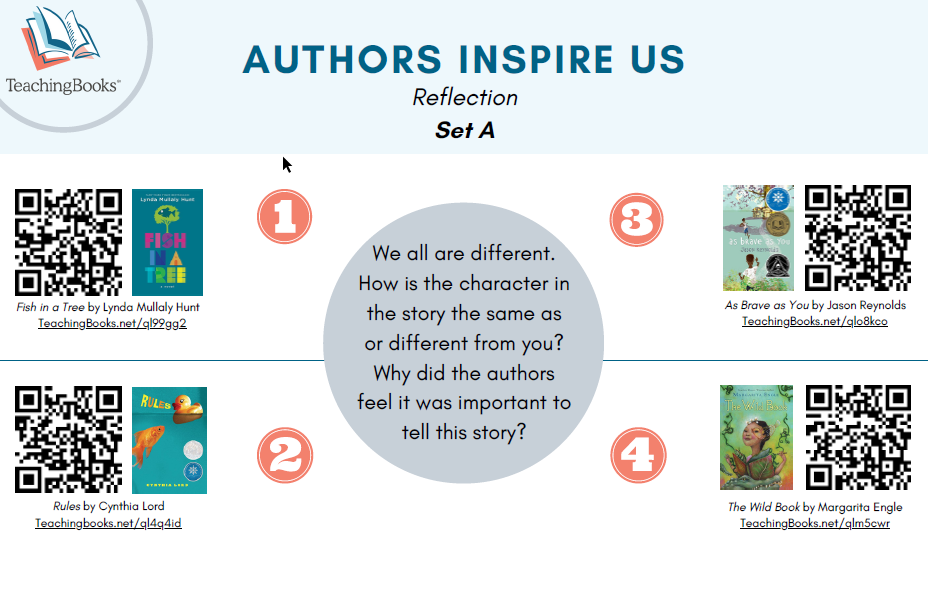
We all are different. How is the character in the story the same or different from you? Why did the authors feel it was important to tell this story?
Resources:
- Fish in a Tree by Lynda Mullaly Hunt | Meet-the-Author Recording
- Rules by Cynthia Lord | Meet-the-Author Recording
- As Brave as You by Jason Reynolds | Meet-the-Author Recording
- The Wild Book by Margarita Engle | Meet-the-Author Recording
Authors Inspire Us 4-8: Set B
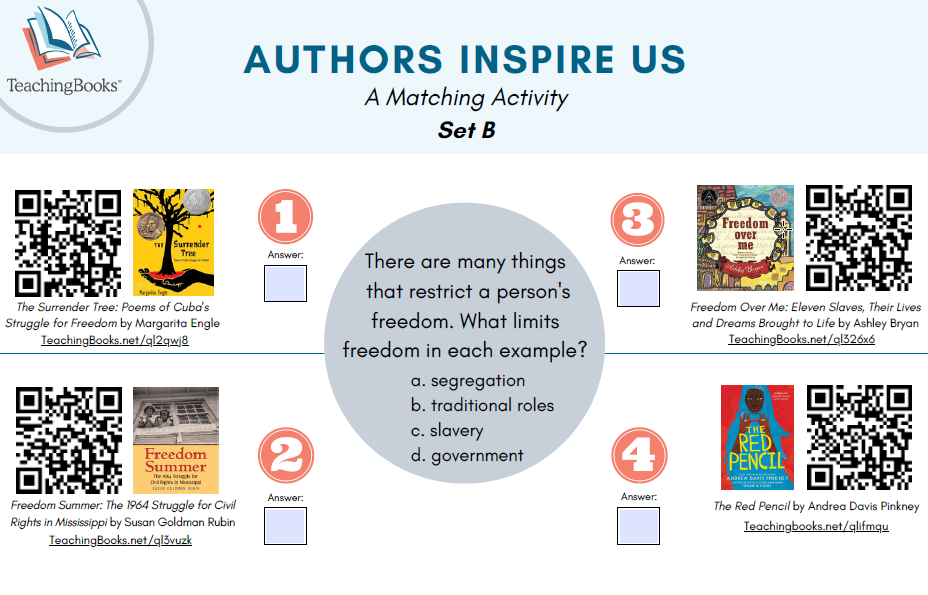
There are many things that restrict a person's freedom. What limits freedom in each example? a. Segregation b. Traditional roles
c. Enslaved people d. Government
Answer Key: 1(d), 2(a), 3(c), 4(b)
Resources:
- The Surrender Tree by Margarita Engle (government) | Meet-the-Author Recording
- Freedom Summer by Susan Goldman Rubin (segregation) | Meet-the-Author Recording
- Freedom Over Me by Ashley Bryan (enslaved people) | Meet-the-Author Recording
- The Red Pencil by Andrea Davis Pinkney (traditional roles) | Meet-the-Author Recording
Activities: Authors Inspire Us 7-12
This set of lesson cards can be used to support learning about author's purpose or inspiration and the writing process.
Scan the QR codes on the front of the card Listen and learn directly from authors Reflect and respond
Authors Inspire Us 7-12: Set A
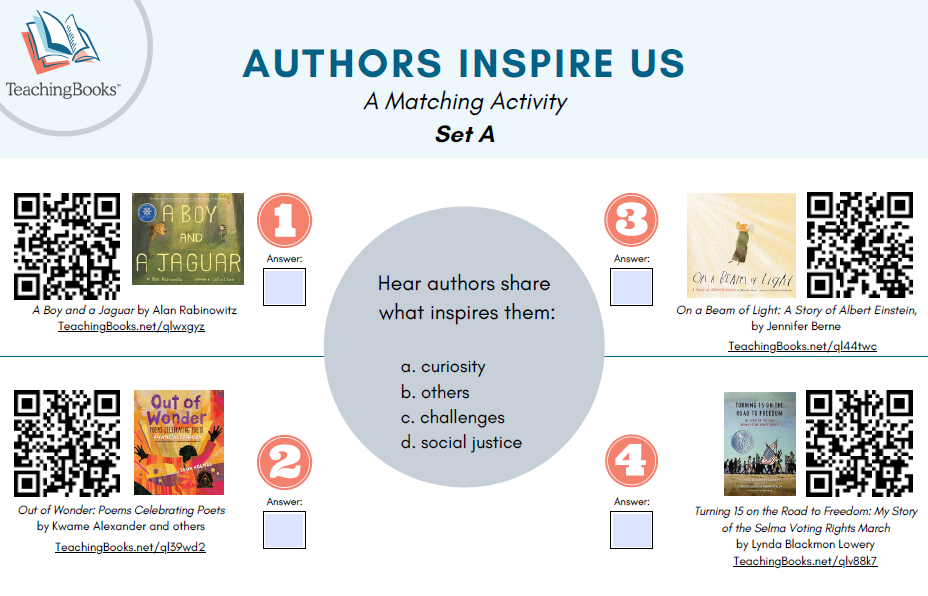
Authors and illustrators are inspired by:
a. Curiosity b. Other authors
c. Challenges d. Social justice
Answer Key: 1(c), 2(b), 3(a), 4(d)
Resources:
- A Boy and a Jaguar Narrated by Alan Rabinowitz (challenges) | Meet-the-Author Recording
- Out of Wonder by Kwame Alexander (other authors) | Meet-the-Author Recording
- On a Beam of Light by Jennifer Berne (curiosity) | Meet-the-Author Recording
- Turning 15 on the Road to Freedom by Lynda Blackmon (social justice) | Meet-the-Author Recording
Authors Inspire Us 7-12: Set B
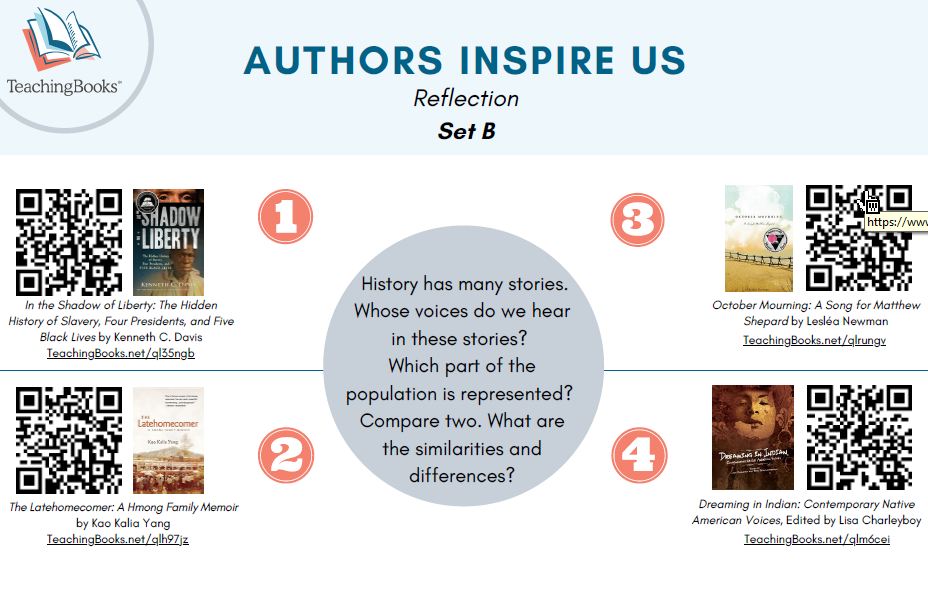
History has many stories. Whose voices are being heard in these stories? Which part of the population is being represented? Listen to two. What are the similarities and differences?
Resources:
- In the Shadow of Liberty by Kenneth C. Davis (enslaved people) | Meet-the-Author Recording
- The Latehomecomer by Kao Kalia Yang (Hmong) | Meet-the-Author Recording
- October Mourning by Lesléa Newman (LGBTQ) | Meet-the-Author Recording
- Dreaming in Indian by Lisa Charleyboy (Indigenous/Native Americans) | Meet-the-Author Recording
Activities: Genre Sleuth K-12
Teaching about genres? Use these examples as mini lessons or practice for identifying genres.
- Scan the QR codes on the the card.
- Listen and learn directly from authors. Reflect and respond.
Genre Sleuth: K-12: Set A
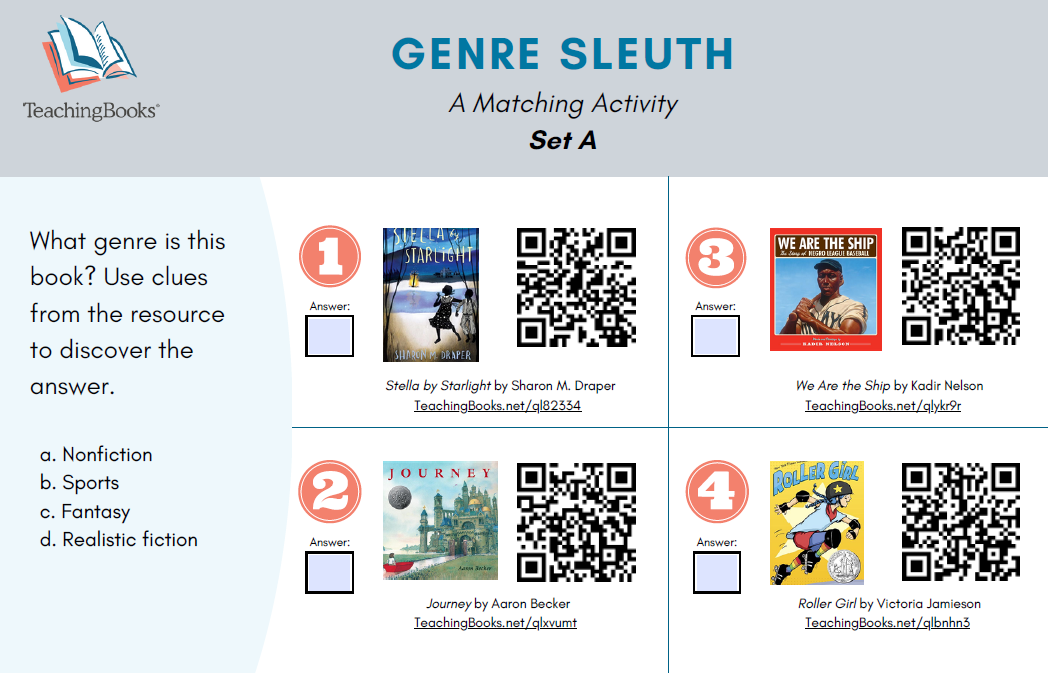
What genre is this book? Use clues from the resource to discover the answer.
a. Nonfiction b. Sports
c. Fantasy d. Realistic fiction
Answer Key: 1(d), 2(c), 3(a), 4(b)
Resources:
- Stella by Starlight by Sharon M. Draper (realistic fiction) | Meet-the-Author Recording
- Journey by Aaron Becker (fantasy/science fiction) | Meet-the-Author Recording
- We Are the Ship by Kadir Nelson (nonfiction) | Meet-the-Author Recording
- Roller Girl by Victoria Jamieson (sports) | Meet-the-Author Recording
Genre Sleuth: K-12: Set B
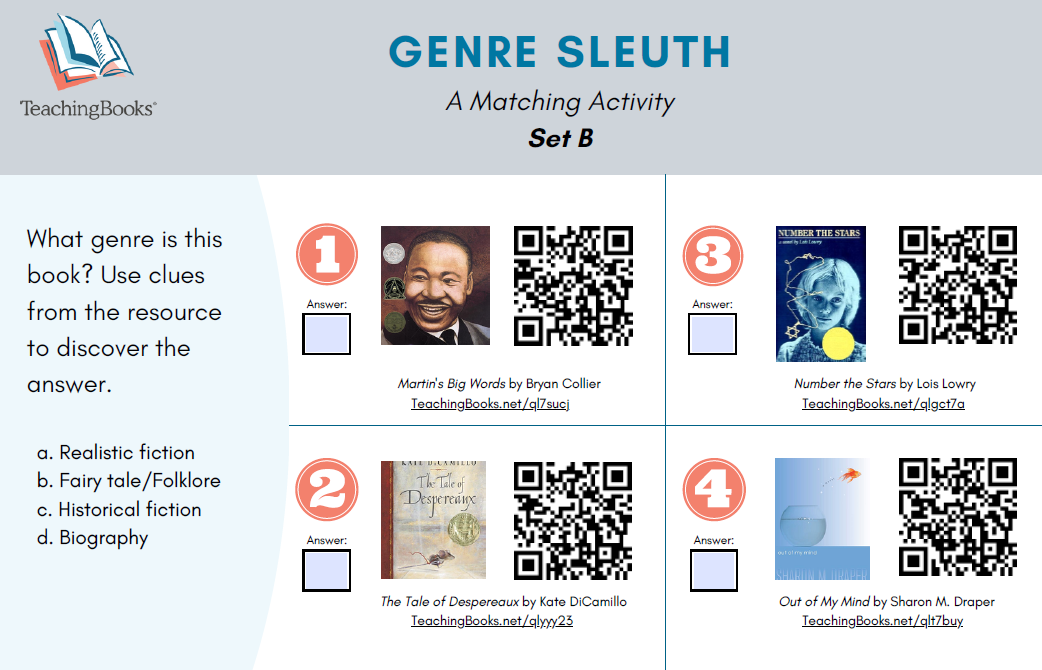
What genre is this book? Use clues from the resource to discover the answer.
a. Realistic fiction b. Fairy tale/folklore
c. Historical fiction d. Biography
Answer Key: 1(d), 2(b), 3(c), 4(a)
Resources:
- Martin's Big Words by Bryan Collier (biography) | Meet-the-Illustrator Recording
- The Tale of Despereaux by Kate DiCamillo (fairy tale /folklore) | Audiobook Excerpt
- Number the Stars by Lois Lowry (historical fiction) | Meet-the-Author Recording
- Out of My Mind by Sharon M. Draper (realistic fiction) | Meet-the-Author Recording
Activities: What's in a Name? 1-12
These original author resources give opportunity to reflect on identity and culture. These mini-autobiographies open a window to reveal a little bit more about each individual and can ground conversations about identity.
Scan the QR codes on the front of the card. Listen and learn directly from authors. Reflect and respond.
What's in a Name? 1-12: Set A
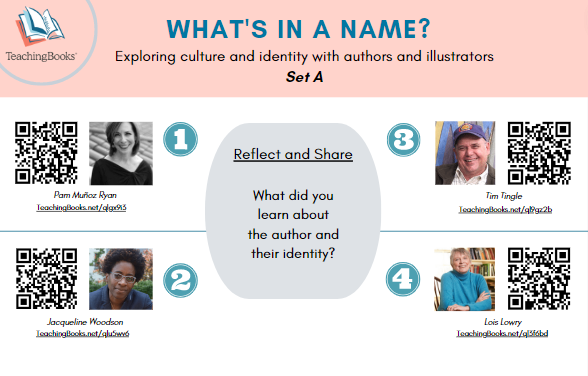
Names can give insight about culture and identity. Listen to each author. What did you learn from each author?
Resources:
- Pam Muñoz Ryan | Audio Name Pronunciation
- Jacqueline Woodson | Audio Name Pronunciation
- Tim Tingle | Audio Name Pronunciation
- Lois Lowry | Audio Name Pronunciation
What's in a Name? 1-12: Set B
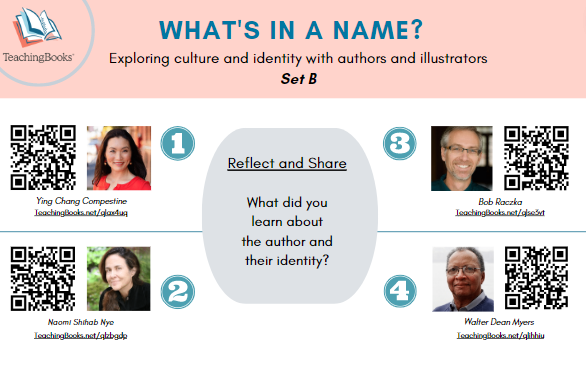
Names can give insight about culture and identity. Listen to each author. What did you learn from each author?
Resources:
- Ying Chang Compestine | Meet-the-Author Recording
- Naomi Shihab Nye | Meet-the-Author Recording
- Bob Raczka | Meet-the-Author Recording
- Walter Dean Myers | Meet-the-Author Recording
Activities: What's in a Name? 1-5
These original author resources give opportunity to reflect on identity and culture. These mini-autobiographies open a window to reveal a little bit more about each individual and can ground conversations about identity.
Scan the QR codes on the front of the card. Listen and learn directly from authors. Reflect and respond.
What's in a Name? 1-5: Set A
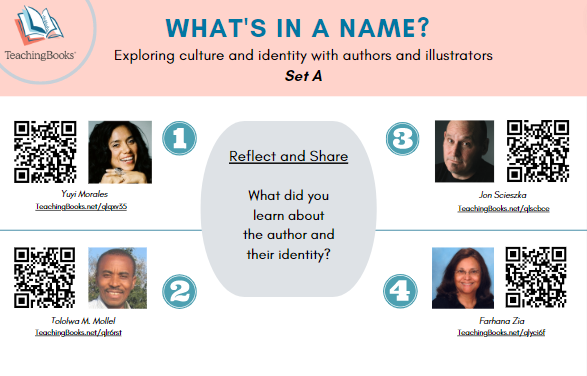
Names can give insight about culture and identity. Listen to each author. What did you learn from each author?
Resources:
- Yuyi Morales | Audio Name Pronunciation
- Tololwa M. Mollel | Audio Name Pronunciation
- Jon Scieszka | Audio Name Pronunciation
- Farhana Zia | Audio Name Pronunciation
What's in a Name? 1-5: Set B
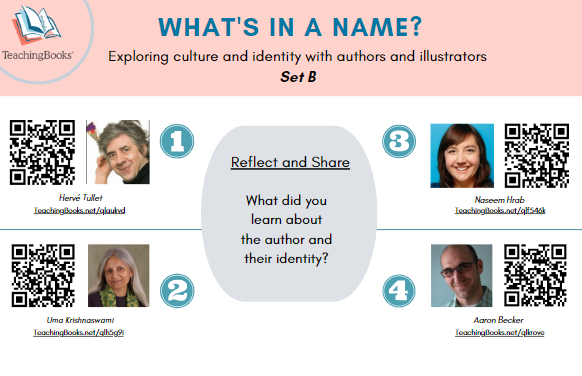
Names can give insight about culture and identity. Listen to each author. What did you learn from each author?
Resources:
- Hervé Tullet | Audio Name Pronunciation
- Uma Krishnaswami | Audio Name Pronunciation
- Naseem Hrab | Audio Name Pronunciation
- Aaron Becker | Audio Name Pronunciation
Activities: What's in a Name? 4-8
These original author resources give opportunity to reflect on identity and culture. These mini-autobiographies open a window to reveal a little bit more about each individual and can ground conversations about identity.
Scan the QR codes on the front of the card. Listen and learn directly from authors. Reflect and respond.
What's in a Name? 4-8: Set A
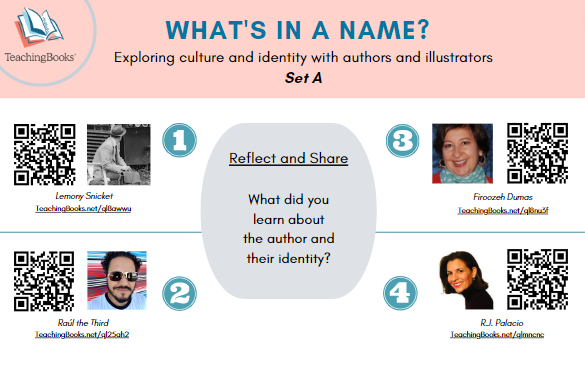
Names can give insight about culture and identity. Listen to each author. What did you learn from each author?
Resources:
- Lemony Snicket | Audio Name Pronunciation
- Raúl the Third | Audio Name Pronunciation
- Firoozeh Dumas | Audio Name Pronunciation
- R.J. Palacio | Audio Name Pronunciation
What's in a Name? 4-8: Set B
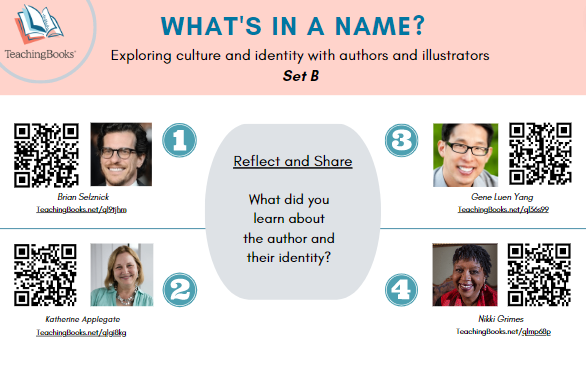
Names can give insight about culture and identity. Listen to each author. What did you learn from each author?
Resources:
- Brian Selznick | Audio Name Pronunciation
- Katherine Applegate | Audio Name Pronunciation
- Gene Luen Yang | Audio Name Pronunciation
- Nikki Grimes | Audio Name Pronunciation
Activities: What's in a Name? 7-12
These original author resources give opportunity to reflect on identity and culture. These mini-autobiographies open a window to reveal a little bit more about each individual and can ground conversations about identity.
Scan the QR codes on the front of the card. Listen and learn directly from authors. Reflect and respond.
What's in a Name? 7-12: Set A
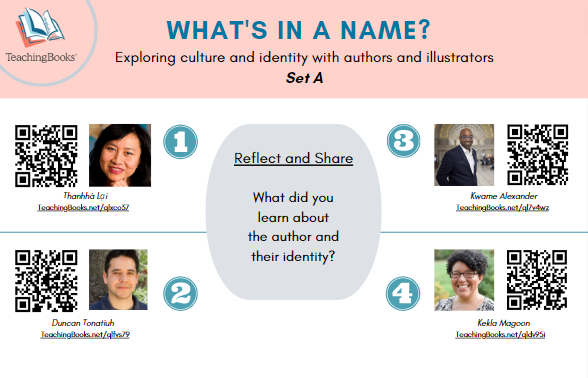
Names can give insight about culture and identity. Listen to each author. What did you learn from each author?
Resources:
- Thanhhà Lại | Audio Name Pronunciation
- Duncan Tonatiuh | Audio Name Pronunciation
- Kwame Alexander | Audio Name Pronunciation
- Kekla Magoon | Audio Name Pronunciation
What's in a Name? 7-12: Set B
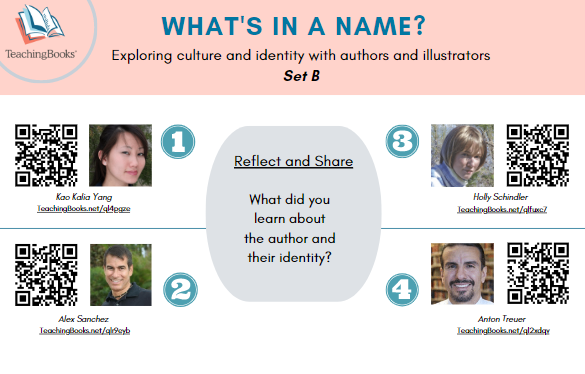
Names can give insight about culture and identity. Listen to each author. What did you learn from each author?
Resources:
- Kao Kalia Yang | Audio Name Pronunciation
- Alex Sanchez | Audio Name Pronunciation
- Holly Schindler | Audio Name Pronunciation
- Anton Treuer | Audio Name Pronunciation

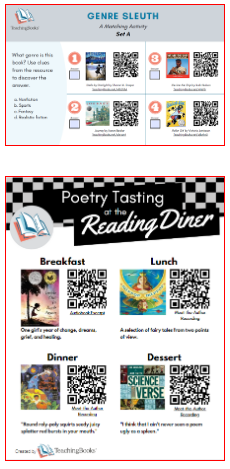
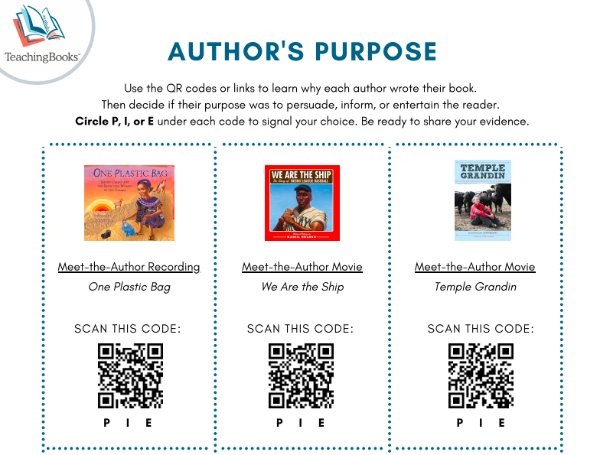 Lesson sheets to learn about authors' purpose or inspiration.
Lesson sheets to learn about authors' purpose or inspiration.